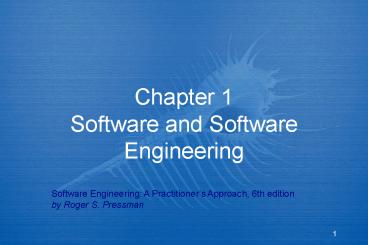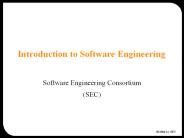Chapter 1 Software and Software Engineering - PowerPoint PPT Presentation
1 / 19
Title:
Chapter 1 Software and Software Engineering
Description:
Software Applications. system software. application software. engineering/scientific software ... it interoperable with other more modern systems or databases. ... – PowerPoint PPT presentation
Number of Views:590
Avg rating:3.0/5.0
Title: Chapter 1 Software and Software Engineering
1
Chapter 1Software and Software Engineering
Software Engineering A Practitioners Approach,
6th edition by Roger S. Pressman
2
Softwares Dual Role
- Software is a product
- Transforms information - produces, manages,
acquires, modifies, displays, or transmits
information - Delivers computing potential of hardware and
networks - Software is a vehicle for delivering a product
- Controls other programs (operating system)
- Effects communications (networking software)
- Helps build other software (software tools
environments)
3
Software Applications
- system software
- application software
- engineering/scientific software
- embedded software
- product-line software
- web applications
- AI software
4
Hardware vs. Software
Hardware Software
Manufactured Wears out Built using components Relatively simple Developed/engineered Deteriorates Custom built Complex
5
Manufacturing vs. Development
- Once a hardware product has been manufactured, it
is difficult or impossible to modify. In
contrast, software products are routinely
modified and upgraded. - In hardware, hiring more people allows you to
accomplish more work, but the same does not
necessarily hold true in software engineering. - Unlike hardware, software costs are concentrated
in design rather than production.
6
Wear vs. Deterioration
- Hardware wears out over time
7
Wear vs. Deterioration
- Software deteriorates over time
8
Component Based vs. Custom Built
- Hardware products typically employ many
standardized design components. - Most software continues to be custom built.
- The software industry does seem to be moving
(slowly) toward component-based construction.
9
Software Complexity
I believe the hard part of building software to
be the specification, design, and testing of this
conceptual construct, not the labor of
representing it and testing the fidelity of the
representation. If this is true, building
software will always be hard. There is inherently
no silver bullet. - Fred Brooks, No Silver
Bullet http//www.computer.org/computer/homepage/
misc/Brooks/
10
Legacy Software
Why must it change?
- It must be fixed to eliminate errors.
- It must be enhanced to implement new functional
and non-functional requirements - Software must be adapted to meet the needs of new
computing environments or technology. - Software must be enhanced to implement new
business requirements. - Software must be extended to make it
interoperable with other more modern systems or
databases. - Software must be re-architected to make it viable
within a network environment.
11
E-Type Systems
- E-Type SystemsSoftware that has been
implemented in a real-world computing context and
will therefore evolve over time
12
Software Evolution
- The Law of Continuing Change (1974) E-type
systems must be continually adapted else they
become progressively less satisfactory. - The Law of Increasing Complexity (1974) As an
E-type system evolves its complexity increases
unless work is done to maintain or reduce it. - The Law of Self Regulation (1974) The E-type
system evolution process is self-regulating with
distribution of product and process measures
close to normal. - The Law of Conservation of Organizational
Stability (1980) The average effective global
activity rate in an evolving E-type system is
invariant over product lifetime.
Source Lehman, M., et al, Metrics and Laws of
Software EvolutionThe Nineties View,
Proceedings of the 4th International Software
Metrics Symposium (METRICS '97), IEEE, 1997, can
be downloaded from http//www.ece.utexas.edu/per
ry/work/papers/feast1.pdf
13
Software Evolution
- The Law of Conservation of Familiarity (1980) As
an E-type system evolves all associated with it,
developers, sales personnel, users, for example,
must maintain mastery of its content and behavior
to achieve satisfactory evolution. - The Law of Continuing Growth (1980) The
functional content of E-type systems must be
continually increased to maintain user
satisfaction over their lifetime. - The Law of Declining Quality (1996) The quality
of E-type systems will appear to be declining
unless they are rigorously maintained and adapted
to operational environment changes. - The Feedback System Law (1996) E-type evolution
processes constitute multi-level, multi-loop,
multi-agent feedback systems and must be treated
as such to achieve significant improvement over
any reasonable base.
Source Lehman, M., et al, Metrics and Laws of
Software EvolutionThe Nineties View,
Proceedings of the 4th International Software
Metrics Symposium (METRICS '97), IEEE, 1997, can
be downloaded from http//www.ece.utexas.edu/per
ry/work/papers/feast1.pdf
14
Software Myths
- Affect managers, customers (and other
non-technical stakeholders) and practitioners - Are believable because they often have elements
of truth, - but
- Invariably lead to bad decisions,
- therefore
- Insist on reality as you navigate your way
through software engineering
15
Software Myths
- If we get behind schedule, we can add more
programmers and catch up. - A general statement about objectives is
sufficient to begin building programs. - Change in project requirements can be easily
accommodated because software is flexible.
16
Software Myths
- Once we write a working program, were done.
- Until I get the program running, I have no way of
assessing its quality. - The only deliverable work product for a
successful project is the working program. - Software engineering will make us create too much
documentation and will slow us down.
17
Management Myths
- We already have a book of standards and
procedures for building software. It does provide
my people with everything they need to know - If my project is behind the schedule, I always
can add more programmers to it and catch up
(a.k.a. The Mongolian Horde concept) - If I decide to outsource the software project to
a third party, I can just relax Let them build
it, and I will just pocket my profits
18
Customer Myths
- A general statement of objectives is sufficient
to begin writing programs - we can fill in the
details later - Project requirements continually change but this
change can easily be accommodated because
software is flexible
19
Practitioners Myths
- Lets start coding ASAP, because once we write
the program and get it to work, our job is done
- Until I get the program running, I have no way
of assessing its quality - The only deliverable work product for a
successful project is the working program - Software engineering is baloney. It makes us
create tons of paperwork, only to slow us down































